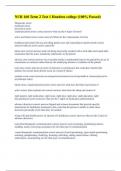NUR 160 Term 2 Test 1 Hondros college (100% Passed)
Diagnostic errors
treatment errors
preventive errors communication errors correct answers what are the 4 types of errors?
active and latent errors correct answers What are the 2 placements of errors
healthcare personnel who are providing patient care and responding to patient needs correct answers what are active errors caused by
latent error correct answers med cart being incorrectly stocked with a look alike and sound alike medication that the nurse mistakenly administers to the patient
adverse error correct answers An event that results in unintended harm to the patient by an act of commission or omission rather than by the underlying disease or condition of the patient
near miss correct answers an error of omission or commission that could have harmed the patient, but serious harm did not occur as a result of chance
sentinel event correct answers an unexpected occurrence involving death or serious physical or psychologic injury
latent errors, organizational/system correct answers what does the blunt end consist of
active errors, direct patient care correct answers what does the sharp end consist of
right patient, right medication, right route, right time, right dose, right education, right documentation correct answers what are the 7 rights of medication administration
advance directives correct answers Signed and witness documents that provide specific instructions for healthcare treatment in the event that the person is unable to make these decisions personally at the time they are needed.
living will and durable power of attorney for healthcare correct answers what are the 2 types of advance directives
nonverbal therapeutic communication correct answers active listening, maintaining silence, nodding, touch, conveying acceptance are all what type of communication
vernal therapeutic communication correct answers closed questioning, open-ended questioning, restating, paraphrasing, clarifying, focusing, reflecting, stating observations, offering information, summarizing are all what type of communication cataracts, glaucoma, macular degeneration, diabetic retinopathy correct answers what are the 4 main causes of visual impairment
presbyopia correct answers farsightedness resulting from a loss of elasticity of the lens of the eye
10 to 22 mm Hg correct answers what is the normal range of intraocular pressure
bacteria correct answers requires a host, synthesizes DNA, RNA and proteins. can produce independently. causes cellular injury by releasing toxins that are either endotoxins or exotoxins
viral infection correct answers a pathogen with a nucleic acid within a protein shell requiring invasion of a host for replication. causes cellular injury by blocking its genetically prescribed protein synthesis processes and using the cells metabolic processes for the reproduction of the virus
fungal infection correct answers caused by a disturbance in the bodys natural flora
protozoa/parasitic correct answers found in dead material in the water and soil and are spread by fecal oral route by ingesting food or water that is contaminated with the spore or cysts
very young or elderly, immunocompromised, immunodeficiency, malnutrition, pre-existing infection with the pathogen, acute or chronic psychologic and environmental stress, use of medications to prevent rejection from a transplant, the presence or treatment of cancer. correct answers individuals at greater risk for infection?
pathogen, host, reservoir, portal of exit, mode of transmission, portal of entry correct answers what is the infection process
fever, swelling, chills, malaise, redness, drainage, pain, respiratory congestion correct answers signs of infection
B and T lymphocytes, neutrophils, monocytes correct answers elevated levels of these would indicate an infection
culture and sensitivity correct answers a test done to identify the invading pathogen and to determine the antimicrobial most likely to be effective in treatment
hand hygiene, clean and disinfect environmental surfaces, avoid close contact with infected individuals or crowded conditions in which bacterial or viral infections may be easily disseminated correct answers what are some infection control measures
assist patient is making goals, assess patient need, motivation, and ability, plan educational intervention to achieve goal and evaluate patient progress towards said goal correct answers what
is the role of the nurse in patient education
the need to learn correct answers for patient education to occur what must be identified




